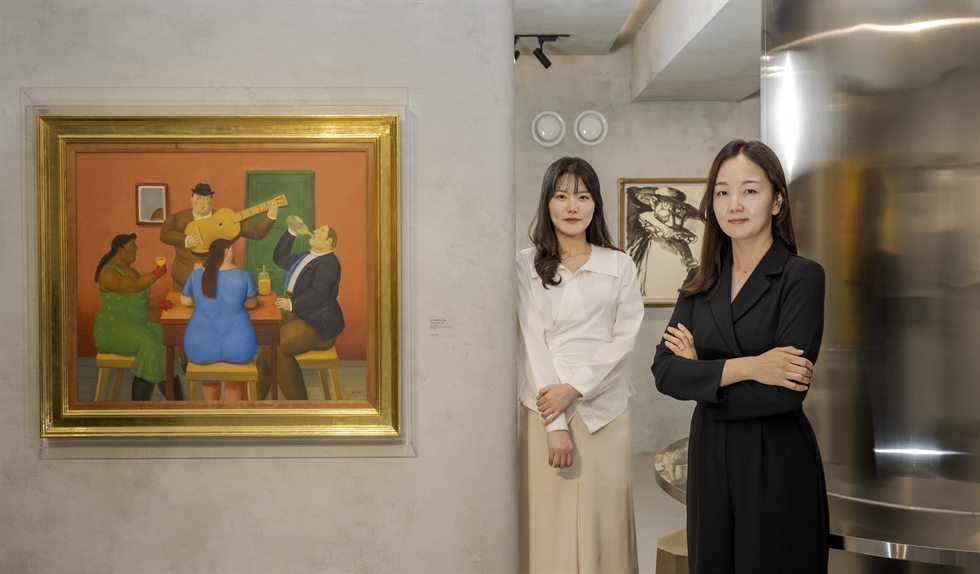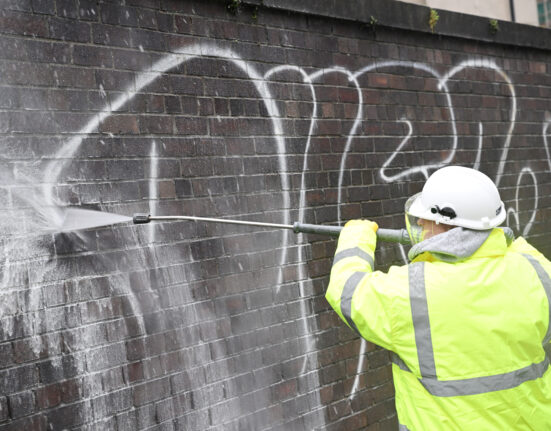[INTERVIEW] Can art become stable investment source?
| Kim Sang-ah, left, and Park Jeong-eun, art analysts at TESSA ASSET, pose at TESSA Museum in Seongsu-dong, Seoul, March 15. Korea Times photo by Shim Hyun-chul |
By Lee Yeon-woo
If you could invest $10 for a chance to own a portion of a painting by Yayoi Kusama, one of the most important Asian artists in the contemporary art world, would you do it?
For many young art lovers in Korea, the answer is a resounding yes. This new approach to art collecting offers the chance for younger people to invest in and profit from the ownership of popular artworks, a departure from the traditional model that was limited to wealthy, middle-aged adults.
The investment process is simple. First, browse a list of the artworks on an investment platform; then, decide which artwork you would like to invest in and how much you are willing to pay for a share of its ownership. Months, or even years later the platform will alert you when it is the best time to sell the artwork for a profit. If more than half of the owners agree to sell, the platform will sell the artwork, and distribute the profits among the hundreds, or thousands of owners, taking a commission for its services.
However, before diving into this particular world of art investment, several questions arise. Which artists and artworks are expected to bring stable profits? When is the best time to sell?
The answers to these complicated and timely decisions come from art analysts.
At a recent interview at TESSA Museum in Seoul’s Seongsu-dong, Kim Sang-ah, a senior art analyst at TESSA ASSET, explained the analysts’ approach to art investment.
“We handle the sourcing and management of blue-chip artworks. We seek to make extra profits by lending the painting to outside exhibitions. But the most important part is ensuring profits for our customers by selling the artwork at the right time,” Kim said.
TESSA ASSET is an affiliate of TESSA, an artwork investment platform. In addition to managing artwork investments, the company exhibits paintings it has purchased in its museum, which is open to customers who are interested in seeing the artwork they own.
Art analysts may appear to be similar to gallerists, as both search for promising artists and distribute their artworks. However, art analysts’ responsibilities are different as they focus on reliably quantifying artwork value.
“We do not rely on feelings or intuition. Instead, we analyze artworks by data and search for meaningful numbers. We make sourcing based on that research,” explained Park Jeong-eun, head of the art analyst team at TESSA ASSET.
| Kim Sang-ah, left, and Park Jeong-eun, art analysts at TESSA ASSET, pose at TESSA Museum in Seongsu-dong, Seoul, March 15. Korea Times photo by Shim Hyun-chul |
Their primary goal is to maximize profits by purchasing artworks with stable value increases and low risk. To identify the so-called “blue-chip” artworks, they use strict standards to review paintings.
“We consider factors such as whether the artist ranks within the top 200 global artist rankings, whether the painting’s failure rate at auction is less than 30 percent of the total, and whether the artist’s annual transaction volume is above 100, and many more. So we choose artists with potential and search for popular, high-demand artworks to purchase. Our standards allow us to identify such artists and purchase highly sought-after artworks,” Kim said.
TESSA has sold 13 artworks and generated an average profit of 25 percent. They even achieved a remarkable 57.31 percent profit with artwork by Ayako Rokkaku, one of the most popular Japanese artists in Korea.
“I believe that any investment product is susceptible to market downturns. However, investing in art is a long-standing tradition that even dates back to medieval times. While it may seem like a trend now with more young collectors entering the market, the art market has always been there,” Kim said.
The Korean market is currently enjoying its greatest boom of all time. According to the Korea Art Market 2022 report, the trade volume of the Korean art market jumped to 922.3 billion won in 2021, and exceeded one trillion won in 2022.
The surge in the art market is largely due to the increased liquidity and a growing number of individual buyers. “Generation X (those born between 1970 and 1979) and millennials (those born between 1980 and 1995) are the two most influential groups of individual collectors on the Korean art market today,” the report wrote.
Even young adults in their 20s are showing strong interest in the art market. KIAF Art Seoul, one of the largest international art fairs in Korea, reported that 28.5 percent of the first-time visitors to the fair in 2021 were in their 20s. Seoul Auction saw an 82 percent increase in its customers who are in their 20s and 30s in 2021.
| People wait in line to enter KIAF ART Seoul, one of the largest international art fairs in Korea, at the lobby of COEX in Samseong-dong, southern Seoul, in this September 2022 file photo. Newsis |
Investing in a portion of artwork has proven lucrative for those who are interested but lack the necessary cash to buy a work outright. According to TESSA, many of its customers were in their 20s when the business first began in 2020.
This new type of investment has since expanded to include traditional art lovers and now more than half of its customers are in their 30s and 40s.
Despite the enthusiasm for art investment, several issues must be addressed to achieve a more mature investment culture.
Last November, financial authorities decided to regulate platforms that allow investors to buy and sell a portion of ownership or copyrights, including TESSA. The regulators consider these fintech startups to be offering platforms for securities trading, which requires registration as a securities business. To protect customers, these platforms must revise their business structures and submit their plans to the Financial Service Commission (FSC) by May 29. After the FSC’s review, they can resume trading.
“We are currently preparing to submit reports to the FSC and also utilizing this time to provide more information to our customers, such as publishing art reports. We believe that offering more information is one way to protect our investors,” an official from TESSA said.
In addition, the two art analysts emphasized the importance of having a genuine affection for art and conducting thorough research when investing.
“It can be difficult to maintain interest over time if you view paintings solely as an investment tool, especially if it does not sell. I recommend investing in a painting that you truly adore and will be pleased to look at over the long term,” Kim said.
Park agreed and added, “We view our customers as future collectors who are just taking their first steps by investing in some portion. That’s why we offer various educational programs and strive to provide as much information as possible.
“Initially, the traditional art scene viewed these platforms negatively, assuming that they only viewed art as a source of profit. However, this stereotype is gradually changing. TESSA now has traditional art lovers among its customers, and we believe we are playing an important role in expanding this market,” Park added.
| Kim Sang-ah, left, and Park Jeong-eun, art analysts at TESSA ASSET, pose at TESSA Museum in Seongsu-dong, Seoul, March 15. Korea Times photo by Shim Hyun-chul |






